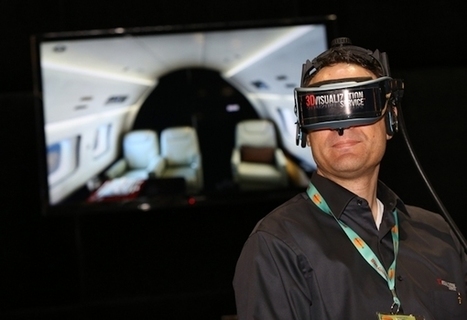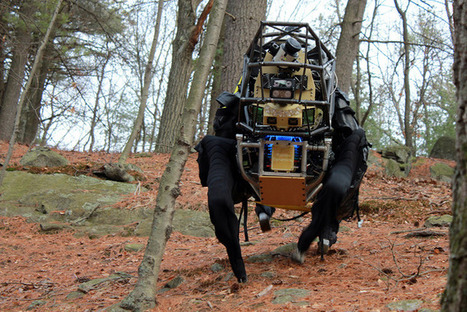While most of the aircraft builders at NBAA [National Business Aviation Association] build their products out of tons of aluminum or increasingly carbon fiber, one new exhibitor here builds them out of thin air. 3DVisualization Service is demonstrating its technology (Booth no. 2885), which allows customers to create a virtual aircraft and enables people to actually walk through it, long before the first metal is ever cut.
Get Started for FREE
Sign up with Facebook Sign up with X
I don't have a Facebook or a X account

 Your new post is loading... Your new post is loading...
 Your new post is loading... Your new post is loading...
Sue Gregory, a lecturer in the School of Education, was recognised for her “innovative adaptation and expansion of virtual world technology to enhance learning and teaching in education and across disciplines”.
KF: Another achievment from members of the VWWG. Well done!
What follows is the description of a research project in which learning practices in online worlds were investigated, and the implications of such practices for online pedagogy were explored through teaching in Second Life.
Part of the conference proceedings of RE:Live 2008
Researchers at Iowa State University and West Chester University of Pennsylvania are creating a virtual world where science and engineering students can confront ethical issues in a virtual environment.
Biological Interactive Objects for Science Education (BIO-SE) (now called Virtual Islands for Biology Education - VIBE) is a collaboration to create learning tools in virtual worlds. What differentiates this effort is that lesson plans and walk-throughs are being created to allow students to navigate through the virtual environment and object manipulation requiring minimal expertise or training in using the VW software. With a land grant from the Fashion Research Institute, BIO-SE was organized to create modular learning lessons in the area of biology on the OpenSim-based ScienceSim. We have now created our own hypergrid to improve our ability to collaborate and make our builds directly accessible to more people. Please see individual User pages for more information on group members and for their specific inworld activities.
Minecraft may be an addictive, open-ended game, but as one New York computer …...
A glimpse of reality in the unreal world The line between fact and fiction is increasingly being distorted October 25, 2012 I’ve glimpsed the future – and it’s disturbing. My insight came while giving a lecture to a group of students. I had their full attention for 100 per cent of the time. Indeed these eager young people never broke eye contact with me; they were hanging on my every word. It felt good. It felt very good.
ane McGonigal is Director of Game Research & Development at Institute for the Future and Chief Creative Officer at SuperBetter Labs. She is author of the New York Times best seller, Reality is Broken.
Ms. McGonigal spoke at this year’s The UP Experience to the topic, "How Gaming Will Change the World." She began by quoting “the number one question my friends, family, and audiences ask me,” which is: "Jane, on your deathbed, won’t you regret having spent so much time playing games?"
Utherverse is announcing today that it has won a patent to build a “scalable” virtual world, or one that can support an unlimited number of players in a single region of an online place. That could allow virtual worlds to achieve a critical mass for events like a convention or a concert.
This Friday, October 26th, Nonprofit Commons is happy to feature John Lester. Next Generation multiuser 3d virtual worlds will be tightly integrated with other key communication technologies such as the web and mobile devices. And a future convergence between the technology of virtual worlds and Augmented Reality will offer many new opportunities. In this presentation, John will discuss some of the key features of next generation virtual worlds and best practices on how to build truly engaging simulations within them. He will also give an overview of ReactionGrid's "Jibe" platform (http://reactiongrid.com/what.aspx).
The Pirate Bay's announcement of file servers on hovering drones may have sounded like a joke, but in fact, these pirate drones already exist.
Project “Electronic Counter Measures” has built a swarm of five fully operational drones that prove that an “aerial Napster” or an “airborne Pirate Bay” is not as futuristic as it sounds.
The theme for this issue of VEJ is Two Worlds Collide. Volume 2 Issue 2. October 2012. |
SBU Demonstrates Largest Resolution Immersive Visualization Facility Ever Built
“Reality Deck” designed to assist scientists, engineers and physicians in tackling modern-age problems requiring vast amounts of data
The Reality Deck, constructed with a $1.4 million National Science Foundation (NSF) grant and a $600,000 match from Stony Brook University, is the first to break the one billion pixel mark with a resolution five times greater than the second largest in the world. To illustrate the resolution, Project Director, Arie E. Kaufman, PhD, Distinguished Professor and Chair of the Computer Science Department and Chief Scientist of CEWIT, said that the entire United States population of approximately 300 million people could take a “class photo” from a satellite, and “there would be enough resolution for each person to be depicted in five pixels in color demonstrating the super-high resolution of the facility.”
Reality Deck by the numbers
Outdoor physical activity is a big component of this, though driving between locations isn’t banned. “You’re like a rat in a maze on the phone,” Hanke said. Then, back at your computer, you can review the larger area and gameplay.
This would be awesome with Google Glass.
Operator training took on a new sense of realism this summer, when the U.S. Department of Energy started up its new immersive simulator at the National Energy Technology Laboratory’s (NETL) Advanced Virtual Energy Simulation Training and Research (AVESTAR) Center in Morgantown, W.Va.
Designed to simulate the operation of an integrated gasification combined cycle (IGCC) power plant with carbon capture, the EYESIM solution from Invensys Operations Management uses 3-D virtual reality simulation to help train power plant control room and field operators. Wearing a stereoscopic headset, IGCC field operators are immersed in a virtual environment with the ability to move throughout the plant, coordinating their activities with control room operators and interacting as if they were in the actual facility.
SciEthics Interactive...
Research Team
Dr. Seth Kahn is co-PI on the project. His scholarship focuses on qualitative research methods and activist rhetoric. He is an Associate Professor of English at West Chester University of Pennsylvania.
Dr. Larysa Nadolny is co-PI on the project. Her research focuses on emerging technology in education, particularly virtual reality and gaming. She is an Assistant Professor in the School of Education at Iowa State University.
Dr. Matt Pierlott is an Assistant Professor of Philosophy at West Chester University of Pennsylvania and co-PI on the project. His research interests focus on the concept of agency both in metaphysics and in its relation to socio-political and economic issues.
Dr. Carolyn Sealfon was an original member of the research team. She is currently the Associate Director of Science Education at Princeton University.
Dr. Joan Woolfrey is the Principal Investigator of the project. She has expertise in bioethics and philosophy, and is an Associate Professor at West Chester University of Pennsylvania.
MinecraftEdu - Bringing Minecraft to the Classroom...
MinecraftEdu is the collaboration of a small team of educators and programmers from the United States and Finland. We are working with Mojang AB of Sweden, the creators of Minecraft, to make the game affordable and accessible to schools everywhere. We have also created a suite of tools that make it easy to unlock the power of Minecraft in YOUR classroom.
Andrew Miller (@betamiller on Twitter) is a National Faculty member for the Buck Institute for Education, an organization specializing in 21st century project-based learning, as well as for ASCD,...
Minecraft in the Classroom is a recent addition to the field of game-based learning. It is a sandbox game where players can create and build, fight off enemies and explore vast landscapes. As is the nature of sandbox games, players can roam free, choosing objectives as they go. Because Minecraft has such open possibilities and potential, the teacher can choose how he or she wants to use it. Just as the student has the ability to be creative, the teacher has the same. That can be overwhelming, but luckily, there is a tool for using Minecraft created by teachers for teachers.
IEEE International Symposium on Technology and Society (ISTAS2013) in Toronto, Canada will bring together participants about people living in smart environments...
The environment around us is becoming "smarter". Soon there will be a camera in nearly every streetlight to do better occupancy sensing,and ultimately a camera in every light fixture. And modern automatic flush toilets, faucets, and sensor-operated showers are starting to use more sophisticated camera-based computer-vision technologies. In a world of smart things like smart lights, smart toilets, smart grids, smart meters, smart roads, and the like, what happens when you have "smart people" (i.e. put sensors on people)? What do we make of the growing numbers of businesses like department stores and restaurants that prohibit cameras, yet display QR codes that require cameras to read and understand?
Researchers at Iowa State University and West Chester University of Pennsylvania are creating a virtual world where science and engineering students can confront ethical issues in a virtual environment.
Special Theme Section: Virtual Worlds for Academic, Organizational, and Life-Long Learning
MANKATO – When adjunct nursing professor Jean Humphries shows up to her Friday morning class in Edina, 11 of her students are there and waiting.
The other 29 show up a moment later, all at the same time, when Humphries touches a screen and connects over the new Cisco TelePresence TX9200 system with a classroom in Wissink Hall at Minnesota State University.
Suddenly, the students in her Nursing Research class are virtually in two places at once, connected through life-size and life-like high-definition video and audio technology that far surpass interactive TV experiences.
KF: Quite a different take on "augmentation" but the idea of remote drones may well find a place in many areas of edcuation - geospatial, risk assessment, mining, architecture, engineering, sociology/anthropology... hey, why not Theatre and drama??
A few weeks back, executives of a U.K. company called Zappar came to my office to show me their augmented reality technology. I have been looking into augmented reality for over a decade and have only seen false starts. |








![[VIBE] Biological Interactive Objects for Science Education (BIO-SE) (now called Virtual Islands for Biology Education - VIBE) | Augmented, Alternate and Virtual Realities in Education | Scoop.it](https://img.scoop.it/g2vdDF46Y3chesgqEIwqIjl72eJkfbmt4t8yenImKBVvK0kTmF0xjctABnaLJIm9)






















